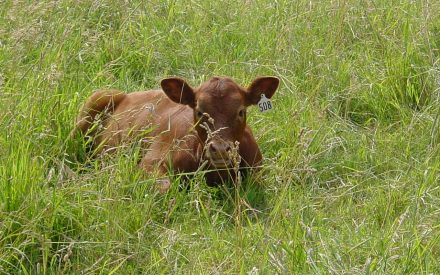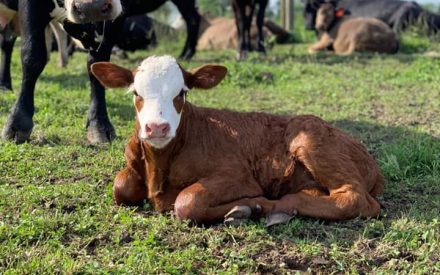When visiting farmers with beef cow-calf enterprises during times when feed prices are high, or hay is in short supply, a few will usually make a comment about roughing the cows through the winter. “Roughing the cows through” usually means that the cows must “make do” with the feed on hand or that which can be obtained cheaply. This feeding strategy often results in the cows losing weight through the winter and having less-than-ideal body condition score (BCS) of 5 to 6 at calving.
In the short-term, this appears to reduce costs and save money. However, if we look into the future, the impact of “roughing the cows through” the winter affects the bottom line much differently than the initial appearance of savings. Cattle with poor BCS produce poorer quality colostrum and less milk during lactation. Calves born to cows with less-than-ideal BCS are more likely to be weaker at birth, more susceptible to illness due to lower quality and quantity of colostrum and have lower weaning weights due to poor milk production. Therefore, the cost of roughing cows through their pregnancy not only affects the coming year’s calf crop, but frequently linger into their future production cycles as described in the following paragraphs.
The goals for a cow calf operation should be a calving interval of 365 days for each cow, and a reasonably short calving season (30 to 45 days), resulting in a uniform calf crop. Uniform groups of feeder calves tend to attract more interest and higher prices from buyers. To achieve a 365-day calving interval, the cow’s postpartum interval (time from calving to when she begins cycling) should be about 60 days for her to be rebred in 80 to 85 days. Research trials examining the effects of cows coming through the winter too thin at calving time, show how poor body condition can negatively influence calving interval. Most herds will likely have a wider range in body condition, due to age, herd social order, genetics etc., and as a result will have less calf crop uniformity.
Table 1 shows the influence of BCS at calving on postpartum interval and why 5 is the target BCS for mature cows at calving.
Table 1. Effect of Body Condition Score (BCS) at parturition on Postpartum Interval (PPI)
| BCS | PPI, days |
|---|---|
| 3 | 88.5 |
| 4 | 69.7 |
| 5 | 59.4 |
| 6 | 51.7 |
| 7 | 30.6 |
(Adapted from Houghton et al., 1990)
This can be taken a step further and the relationship between a cow’s BCS at calving and total income can be compared (Table 2). As BCS decreased, pregnancy rate and weaning weight both declined. This can lead to a severe reduction in income.
Table 2. Relationship of body condition score (BCS) to beef cow performance and income.
| BCS | Pregnancy rate, % | Calving interval, d | Calf ADG, lb | Calf WW, lb. | Calf Price, $/100 lb.** | $/Cow Exposed* |
|---|---|---|---|---|---|---|
| 3 | 43 | 414 | 1.60 | 374 | 150 | 241.23 |
| 4 | 61 | 381 | 1.75 | 460 | 140 | 392.84 |
| 5 | 86 | 364 | 1.85 | 514 | 135 | 596.75 |
| 6 | 93 | 364 | 1.85 | 514 | 135 | 645.33 |
(adapted from Kunkle et al., 1994) * Income per calf x pregnancy rate. ** late summer 2021 feeder prices
Roughing the cows through winter may look good up front but the examples shown above indicate that the long-term costs are real. When overwintering the cows, options to save money may include grouping the cows with similar nutritional needs and supplement accordingly for that group. An example of grouping is putting the 1st and 2nd calf cows into a separate group as they are still growing themselves in addition to producing a calf. In addition, test your forages so you know what you have and then purchase the additional feed you need, rather than guess and not spend your money as efficiently as possible. Depending on your forage quality, some cows will need little if any supplementation and others may need more.
References:
Houghton, P.L., R.P. Lemenager, L.A. Horstman, K.S. Hendrix, and G.E. Moss. 1990. Effects of Body Composition, Pre- and Postpartum Energy Level and Early Weaning on Reproductive Performance of Beef Cows and Preweaning Calf Gain. J. Anim. Sci. 68:1438-1446.
Kunkle, W.E., R.S. Sands and D.O. Rae. 1994. Effect of body condition on productivity in beef cattle. M.
Fields and R. Sands (ed.) Factors Affecting Calf Crop. Pp. 167-178. CRC Press
Reviewed by:
Dr. Sandy Stuttgen D.V.M., Ryan Sterry and Carolyn Ihde, UW-Madison Division of Extension Agriculture Educators in Taylor, St. Croix, Richland and Crawford Counties.


 Planning Ahead for Newborn Calf Processing
Planning Ahead for Newborn Calf Processing Resources for Handling Down Cattle
Resources for Handling Down Cattle Navel Care for Beef x Dairy Calves
Navel Care for Beef x Dairy Calves Don't Forget the Bull!
Don't Forget the Bull!


